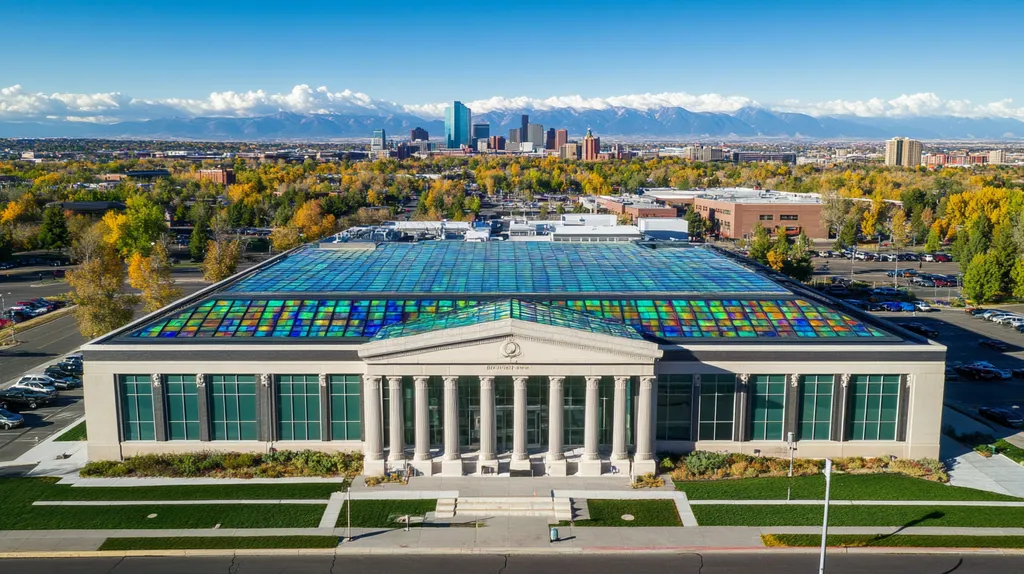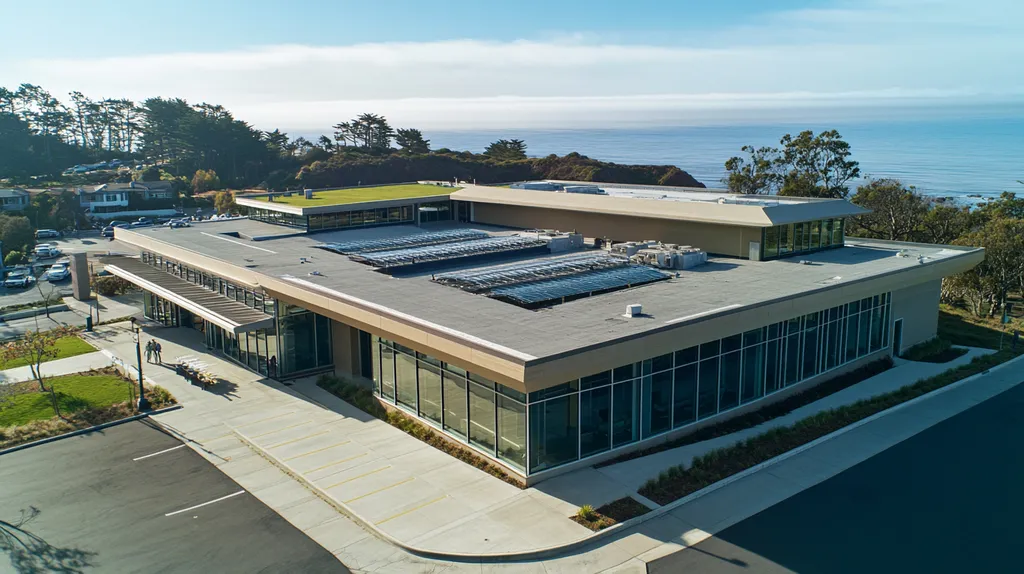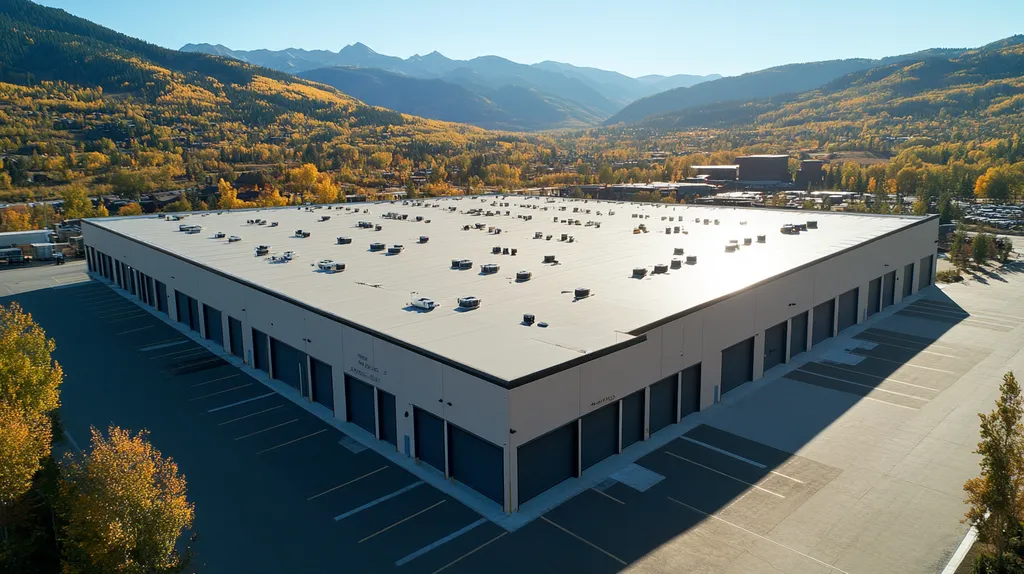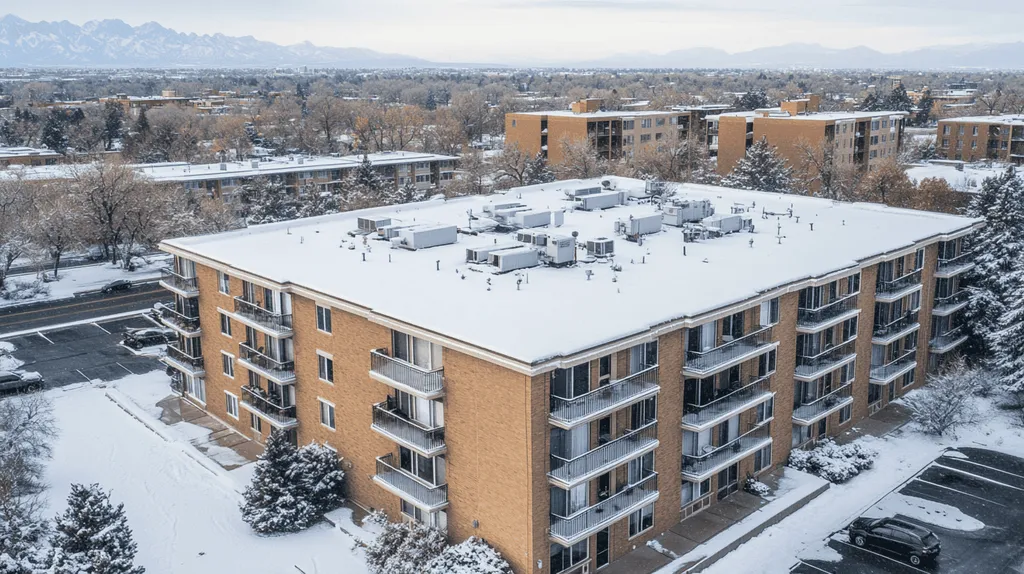In an era of soaring energy costs, commercial property owners face mounting pressure to optimize their buildings’ efficiency. Studies show that reflective roofing materials can reduce cooling expenses by up to 30%, yet many facilities still rely on traditional dark surfaces that absorb heat.
As urban temperatures continue to rise, the strategic use of reflective materials has become essential for sustainable building management. From advanced polymer coatings to specialized membranes, these innovative solutions offer practical ways to combat heat absorption while trimming operational costs.
This guide examines the fundamentals of reflective roofing, breaking down the science, applications, and crucial decision factors that property managers need to understand.
SECTION 1: THE BASICS EXPLAINED
With energy prices on the rise, property owners are actively searching for innovative ways to cut costs. Reflective materials, often known as “cool roofing,” are essential in keeping building temperatures manageable. As urban areas continue to heat up, grasping the advantages of reflective roofing materials becomes crucial—offering not just short-term savings but also a pathway towards sustainability. This section will break down what reflective materials are, their importance to commercial buildings, and how they work to boost energy efficiency.
What It Is (In Plain Language)
Reflective materials are specialized roofing products that are designed to reflect sunlight rather than absorb it. Think of them as shields for your roof: materials like coatings and membranes possess a high solar reflectance index (SRI) and are available in various colors, such as white or light shades, which work to keep rooftop temperatures lower.
When property owners opt for reflective roofing, they are investing in enhanced energy performance. Unlike conventional dark roofs, these reflective alternatives help to curb heat absorption, making indoor spaces cooler and more comfortable. This creates a better environment for occupants and also extends the lifespan of the roof itself.
Recognizing the various types of reflective materials is key. Each type boasts different levels of effectiveness, durability, and installation methods, all of which influence energy savings. For instance, single-ply membranes with reflective properties can lead to significant energy reduction while being easy to care for.
In essence, reflective materials symbolize a shift toward smarter roofing choices, emphasizing efficiency and sustainability in the commercial sector.
Why It Matters (To Your Building)
The benefits of reflective roofing materials go well beyond looks. They are indispensable for reducing energy consumption, translating directly into lower utility bills. A building equipped with a reflective roof can save up to 20% on cooling costs, making a remarkable impact on a property owner’s finances.
Moreover, using reflective materials supports environmental sustainability by reducing energy demand, which in turn lowers carbon emissions. This aligns with global efforts to combat climate change. For businesses pursuing sustainable certifications like LEED, installing reflective roofing is a strategic and effective move.
Additionally, in many regions, local building codes now promote or even require energy-efficient practices. By embracing reflective roofs, property owners not only comply with regulations but also enhance their properties’ marketability.
Ultimately, choosing reflective materials can bolster asset value in an increasingly eco-conscious marketplace. This approach improves a building’s performance while signaling responsible management to tenants and stakeholders.
How It Works
The real strength of reflective materials lies in their capacity to manage thermal energy. By reflecting sunlight, these materials drastically reduce heat gain during the warmer months. This minimizes the need for air conditioning, easing the overall thermal burden on the building.
Many reflective materials include specially formulated coatings that enhance their performance. For example, these coatings can be tailored to achieve higher reflectance levels, ensuring that less heat seeps through the roof and into the building.
Furthermore, using reflective materials positively impacts the longevity of a roof. By lessening thermal stress, these materials reduce wear and tear, leading to fewer repairs and replacements in the long run. This preventive approach can lead to significant savings in maintenance costs.
In summary, grasping how reflective materials operate empowers property owners to make informed decisions. The combination of energy savings, regulatory compliance, and extended roof life makes them a vital element of modern commercial roofing strategies.
SECTION 2: PRACTICAL APPLICATIONS
As energy prices soar, the necessity for commercial property owners to embrace reflective roofing materials is reaching a critical point. Studies indicate that these innovative roofs can lower energy costs by as much as 20%. In hotter climates, they significantly reduce cooling demands, which not only extends the lifespan of the roof but also helps alleviate the urban heat island effect. This section will delve into common applications for reflective materials, when their usage is most beneficial, and how they interact with other building systems.
Common Uses & Examples
Reflective materials shine in various commercial applications, especially on flat and low-slope roofs. For example, EPDM (ethylene propylene diene monomer) roofing now comes with a reflective finish, ideal for industrial facilities like warehouses and manufacturing plants. These materials help regulate indoor temperatures, which can lead to substantial energy savings.
TPO (thermoplastic olefin) is another popular option, valued for its strong reflective properties. Many retail spaces have reported cooling cost reductions of up to 30% after switching to reflective TPO systems. This change doesn’t just save money; it also boosts comfort for customers and employees alike.
Institutions such as schools and hospitals also benefit significantly from reflective roofs. These surfaces create a more pleasant environment for students and patients while helping to combat health-related issues stemming from excessive heat indoors.
In essence, the versatility of reflective materials makes them a go-to choice across various commercial roofing sectors, resulting in significant long-term savings and enhanced building performance.
When You Need It Most
The importance of reflective roofing materials becomes especially pronounced in warmer climates and urban areas where green spaces are scarce. Buildings in densely populated cities often suffer from the “urban heat island” effect, in which dark surfaces absorb excessive heat. Reflective materials play a vital role in mitigating this issue, making them essential for urban infrastructure.
Moreover, businesses aiming for energy efficiency certifications, such as LEED (Leadership in Energy and Environmental Design), must prioritize reflective roofing. Achieving these certifications elevates property values while demonstrating a genuine commitment to sustainability.
Commercial buildings undergoing roof replacements should seize the opportunity to install reflective materials. Doing so not only enhances energy efficiency but can also lead to significant reductions in utility bills.
In summary, implementing reflective roofing materials is essential when energy efficiency, urban heat reduction, or sustainability certifications are at stake.
Interactions With Other Systems
Reflective roofing materials are just one part of a larger system; they work in tandem with other building components to maximize benefits. For instance, installing reflective roofing in conjunction with improved insulation is crucial. The combination helps keep indoor temperatures stable while trimming down energy use.
These roofs also lessen the strain on HVAC systems by reducing the cooling load. Consequently, air conditioning units can enjoy prolonged lifespans and lower maintenance costs, enhancing overall building efficiency.
Proper drainage systems are another vital consideration when integrating reflective materials. Effective drainage prevents water accumulation, which can damage both the reflective surface and the underlying structure. A well-planned drainage approach complements the advantages of reflective roofs.
Furthermore, combining reflective materials with ventilation systems amplifies overall efficiency. Enhanced airflow can effectively disperse heat, making reflective roofs even more effective. By understanding how these systems interact, property owners can make more informed decisions for improved building performance.
SECTION 3: KEY TERMINOLOGY DECODED
Understanding the terminology surrounding reflective materials in commercial roofing is essential for making informed decisions. Misinterpretations can lead to unnecessary expenses and reduced energy efficiency. For instance, energy loss caused by misconceptions can increase utility bills significantly. This section breaks down crucial terms, clarifies industry jargon, and simplifies measurement units, allowing property owners and facility managers to confidently engage with roofing technology.
Essential Terms Explained
Reflective roofing, commonly known as ‘cool roofing,’ is engineered to reflect more sunlight than traditional roofing systems. This ability prevents heat absorption, leading to reduced cooling costs for the building. Widely used materials include reflective coatings, single-ply membranes, and modified bitumen systems.
Another vital term is the Solar Reflectance Index (SRI). This metric measures a roof’s effectiveness at rejecting heat, with higher SRI values indicating better energy efficiency. A roof with a strong SRI can make a noticeable difference in energy savings.
Emissivity is an equally important concept and describes how well a material releases heat it has absorbed. Materials with lower emissivity values retain less heat, which helps maintain comfortable indoor temperatures without relying heavily on cooling systems.
Property owners should also remember that regular maintenance is crucial for extending the lifespan of reflective roofs. Neglecting upkeep can diminish a roof’s reflective qualities, resulting in premature failure and increased costs.
Industry Jargon Translated
The commercial roofing industry often uses technical language that may be perplexing. For example, ‘thermal performance’ refers to how effective a roofing system is at insulating against heat flow, thus influencing energy consumption.
Another key term is ‘reflectivity,’ which describes a roof’s ability to bounce back solar radiation. This quality is fundamental in minimizing heat absorption and ensuring cooler building interiors.
‘Ponding water’ denotes water that collects on the roof after rainfall. This accumulation can impair the integrity of reflective materials, making it crucial to manage and prevent to avoid damage.
Additionally, ‘roof asset management’ involves strategies for overseeing a roof’s performance and maintenance. Implementing a solid management plan can ensure the longevity and effectiveness of reflective roofing systems.
Measurement & Units Simplified
When evaluating roofing products, property owners will encounter various measurements that can seem overwhelming. The SRI is scored on a scale from 0 to 100, with higher scores indicating superior reflective qualities. Understanding this scale simplifies comparisons between roofing products.
Another important measure is Solar Reflectance (SR), which ranges from 0 to 1 and indicates how much sunlight is reflected. Knowing this metric is crucial for assessing the energy performance of different materials.
The R-value also comes into play; it represents thermal resistance, with higher values denoting better insulation. A high R-value is critical for increasing energy efficiency.
Lastly, roofing life expectancy is typically specified in years. Reflective materials often have a durability range of 20 to 30 years, influenced by maintenance routines and local climate conditions.
SECTION 4: DECISION FACTORS
Choosing reflective materials for commercial roofs isn’t just about aesthetics—it’s a smart move for energy efficiency and environmental stewardship. Research indicates that reflective roofs can slash cooling energy usage by up to 30%, offering significant savings over time. As property owners navigate this decision, they need to consider costs, performance trade-offs, and material durability to ensure they make the best choice for their building.
Cost Considerations
While reflective roofing materials might have a higher initial price tag compared to traditional options, the potential long-term savings in energy bills often make them a worthwhile investment. It’s essential for property owners to look beyond only the upfront costs to see the bigger picture of ongoing savings.
Additionally, some reflective materials might qualify for tax incentives or rebates, further enhancing their financial attractiveness. It’s wise to evaluate expected energy rates and cooling needs when calculating the overall financial impact.
Choosing reflective roofing can also positively affect insurance costs and boost property valuation over time. Lower energy expenses contribute to a property’s profitability and attractiveness to potential tenants.
In summary, making a smart investment in reflective roofing materials hinges on understanding the difference between upfront and long-term costs.
Performance Trade-offs
When opting for reflective roofing, it’s crucial not to sacrifice performance for either cost or appearance. Reflective materials come in different types, each bringing unique benefits, but also some drawbacks. For example, while one material may shine in reflectivity, it might not offer adequate thermal resistance, impacting indoor climate control.
Weather resilience is another vital consideration. High-quality reflective membranes are designed to withstand UV exposure and harsh weather, whereas less expensive alternatives may deteriorate more rapidly, leading to costly repairs.
The roof’s pitch and the local climate can significantly influence how well reflective materials work. It’s essential to understand how these materials perform in specific environmental conditions to achieve optimal energy efficiency.
Ultimately, property owners need to strike a balance between reflection efficiency and other necessary performance attributes, ensuring they select a robust and effective roofing solution.
Lifespan & Durability Factors
The longevity of reflective roofing materials is a critical factor that can profoundly affect long-term costs. Generally, higher-quality materials boast greater durability, which translates to fewer necessary repairs and replacements.
Some reflective membranes can endure for over 30 years with proper maintenance, while cheaper options may require replacement within a decade. This durability can translate into substantial savings in both material and labor costs.
Environmental elements—like temperature shifts and pollution—also impact material durability. Property owners should factor in local climate conditions when choosing reflective materials to ensure they can withstand the elements.
Regular maintenance is key to maximizing the lifespan of any roof system. Establishing a good maintenance routine can prolong the life and efficiency of reflective materials, supporting sustainable building practices in the long run.
SECTION 5: COMMON CHALLENGES
The adoption of reflective materials in commercial roofing can lead to impressive energy savings and sustainability efforts. However, property owners and facility managers must navigate a set of common challenges that could jeopardize these benefits. Issues such as inadequate installation and insufficient maintenance can diminish the performance and lifespan of reflective roofs. Identifying these problems early on is essential for protecting investments and maximizing energy-efficiency gains.
Frequent Problems & Solutions
Surface degradation is a prevalent issue with reflective roofing. Over time, exposure to harsh weather conditions can cause cracks and discoloration. Regular inspections can help catch these problems early, allowing for timely repairs to prevent further damage and maintain energy efficiency.
Poor drainage is another significant concern. If water pools on the roof, it can lead to serious deterioration of the roofing material. Installing an effective drainage system can help resolve this issue, ensuring that moisture is directed away and prolonging the life of reflective materials.
Accumulation of dirt and debris is also detrimental to reflective roofs, as it can significantly reduce their efficiency. Regular cleaning should be part of the maintenance routine to keep surfaces clear and ensure optimal reflectivity, contributing to energy savings.
Compatibility issues can arise when integrating reflective materials with existing roofing systems. Consulting professionals during installation ensures that different materials adhere properly, maximizing overall roofing performance.
Warning Signs To Watch For
Property owners should watch for several warning signs that may indicate issues with reflective roofing. Noticeable discoloration is a key indicator, as it often suggests degradation of the roof’s reflective properties, ultimately leading to increased cooling costs.
Ponding water after rain is another red flag that warrants attention. This condition poses risks to structural integrity if not promptly addressed. Regular monitoring of drainage areas is crucial to prevent water accumulation that could harm the roof.
Visible cracks or blisters indicate potential underlying problems that compromise the roofing system’s integrity. Observing these defects requires immediate action—consulting a roofing expert can prevent further complications.
An unexpected spike in energy bills can also signal reduced efficiency. If energy costs spike without a change in conditions, it could indicate a failing roofing system. Conducting regular energy audits can help property owners understand their roof’s performance and take corrective action.
Preventative Approaches
Proactive maintenance is key to avoiding common challenges associated with reflective roofs. Instituting a regular inspection and maintenance schedule can help identify potential issues before they escalate. A well-maintained roof not only enhances longevity but also maximizes energy savings.
Training staff on best practices for roof care can mitigate risks. Educating them about the importance of keeping surfaces clean ensures efficient performance. A knowledgeable team leads to quicker reporting of any concerns.
Implementing a well-designed drainage system is critical from the outset. Proper drainage can prevent standing water, which may damage reflective materials over time. Collaborating with roofing experts during installation helps anticipate drainage needs effectively.
Lastly, incorporating regular energy assessments into management routines is beneficial. Monitoring energy usage provides insights into roof performance, allowing for prompt corrective actions to enhance energy efficiency.
SECTION 6: NEXT STEPS & RESOURCES
As commercial property owners and facility managers confront rising energy expenses, the implementation of reflective roofing materials has never been more critical. Studies reveal that buildings equipped with reflective roofs can slash cooling costs by as much as 20%. To ensure these benefits are realized, it’s essential to know how to effectively select and implement these materials. This section outlines vital questions to ask prospective roofing providers, highlights important industry standards, and suggests avenues for further education.
Questions To Ask Providers
When choosing a roofing provider, asking the right questions can make all the difference. First, find out how long the provider has worked with reflective materials. Their experience can directly influence the quality of your roof’s installation.
Next, verify their certifications. Providers should adhere to established industry standards set by organizations like the Cool Roof Rating Council (CRRC). This adherence assures you of compliance and effective performance.
Inquire about the types of reflective materials they offer and their unique energy efficiency ratings. It’s crucial to choose products that align with your building’s specific energy needs.
Finally, don’t forget to ask about warranty options. A solid warranty protects against premature roof failure, ensuring that your investment in energy efficiency is secure.
Industry Standards & Guidelines
Understanding industry standards is vital for the successful installation of reflective roofing materials. The Cool Roof Rating Council (CRRC) provides a list of rated products that includes their reflectivity values, helping property owners select the best options for energy efficiency.
Additionally, the American Society of Heating, Refrigerating and Air-Conditioning Engineers (ASHRAE) offers guidelines focused on energy efficiency that complement reflective roofing practices.
Local building codes also play a role in determining required reflectivity levels for commercial roofs. Being aware of these regulations ensures compliance while maximizing energy-saving benefits.
Keeping an eye on evolving industry trends, particularly the emphasis on sustainability, is also essential. Aligning your roofing strategy with these trends can lead to enhanced operational benefits.
Further Learning Simplified
Broadening your knowledge of reflective roofing can significantly impact decision-making. Many online platforms provide webinars, articles, and guides dedicated to energy efficiency in commercial roofing. Websites like the Cool Roof Rating Council offer a wealth of resources.
Industry associations frequently host workshops and certification programs. These opportunities are excellent for deepening your understanding of reflective materials and their applications.
Attending industry conferences is another effective way to stay current on best practices and innovations in reflective roofing. Networking with experts at these events can offer invaluable insights.
Lastly, consider seeking guidance from roofing engineers or sustainability consultants who specialize in energy-efficient building practices. Their expertise can help make strategic decisions regarding roofing solutions.
The Bottom Line
With commercial energy costs projected to rise 30% over the next decade, reflective roofing materials have moved from an optional upgrade to a critical necessity for property owners.
These innovative solutions offer documented savings of up to 20% on cooling expenses while extending roof lifespans by reducing thermal stress and UV damage.
As urban temperatures continue climbing and energy efficiency regulations tighten, buildings without reflective roofing risk becoming increasingly expensive to operate and potentially non-compliant with emerging standards.
The time to implement reflective roofing solutions is now, before rising costs and stricter regulations force hasty decisions that compromise long-term performance and return on investment.
Property owners who take decisive action today position themselves to realize significant operational savings while future-proofing their facilities against evolving energy challenges.
FREQUENTLY ASKED QUESTIONS
Q. What are reflective materials for commercial roofs?
A. Reflective materials are designed to reflect sunlight instead of absorbing it, keeping rooftop temperatures lower. These materials help reduce indoor heat, leading to substantial energy savings. By reducing heat absorption, they enhance occupant comfort and extend the life of your roof.
Q. When should I use reflective materials on my commercial roof?
A. Reflective materials are particularly useful in hot climates, especially where urban heat is a concern. If you’re replacing your roof or seeking energy efficiency certifications, it’s the perfect time to consider these materials for long-term savings and reduced cooling costs.
Q. What does SRI mean for my industrial roof?
A. SRI stands for Solar Reflectance Index, measuring how effectively a roof reflects sunlight. Higher SRI values indicate better energy efficiency, making it essential for selecting the most suitable reflective materials for your building.
Q. How can I ensure my reflective roof lasts longer?
A. Regular maintenance is key to prolonging the lifespan of reflective roofs. This includes inspections for damage, cleaning debris, and ensuring proper drainage to prevent water accumulation. A well-maintained roof can offer more years of energy efficiency and performance.
Q. What are the common challenges with reflective materials?
A. Common challenges include surface degradation, poor drainage, and accumulation of dirt. Regular inspections and a proper maintenance plan can help mitigate these issues, ensuring that your reflective roof continues to perform efficiently over time.
Q. What questions should I ask roofing providers about reflective materials?
A. Inquire about their experience with reflective materials, certifications, types offered, and warranty options. Understanding these aspects ensures you choose a knowledgeable provider who can deliver quality service and products for your roofing needs.
Q. Are there tax incentives for installing reflective roofs?
A. Yes, some reflective roofing materials may qualify for tax incentives or rebates. It’s important to research and check with local authorities to understand available financial benefits that can enhance your investment in energy efficiency.











